Effect of Pain Relief on Diagnosis of Acute Abdominal Pain: A Report
VerifiedAdded on 2022/08/23
|9
|2423
|15
Report
AI Summary
This report investigates the effect of pain relief on the diagnosis and surgical treatment of acute abdominal pain, based on evidence-based practices. The study addresses the clinical question of whether pain relief before diagnosis impacts the surgical treatment of a 45-year-old male patient. The research methodology involves a PICO question format, searching databases like CINAHL, and prioritizing randomized controlled trials and systematic reviews. The critical appraisal focuses on a study by Manterola et al. (2011), highlighting the search methodology, the rigor of the review process, and the generalizability of the findings. The report also discusses barriers to the uptake of evidence-based practices, such as lack of time and skills, and proposes strategies for evaluation and implementation, including interviews, questionnaires, and creating a supportive organizational culture. The references include a range of sources supporting the evidence-based approach.
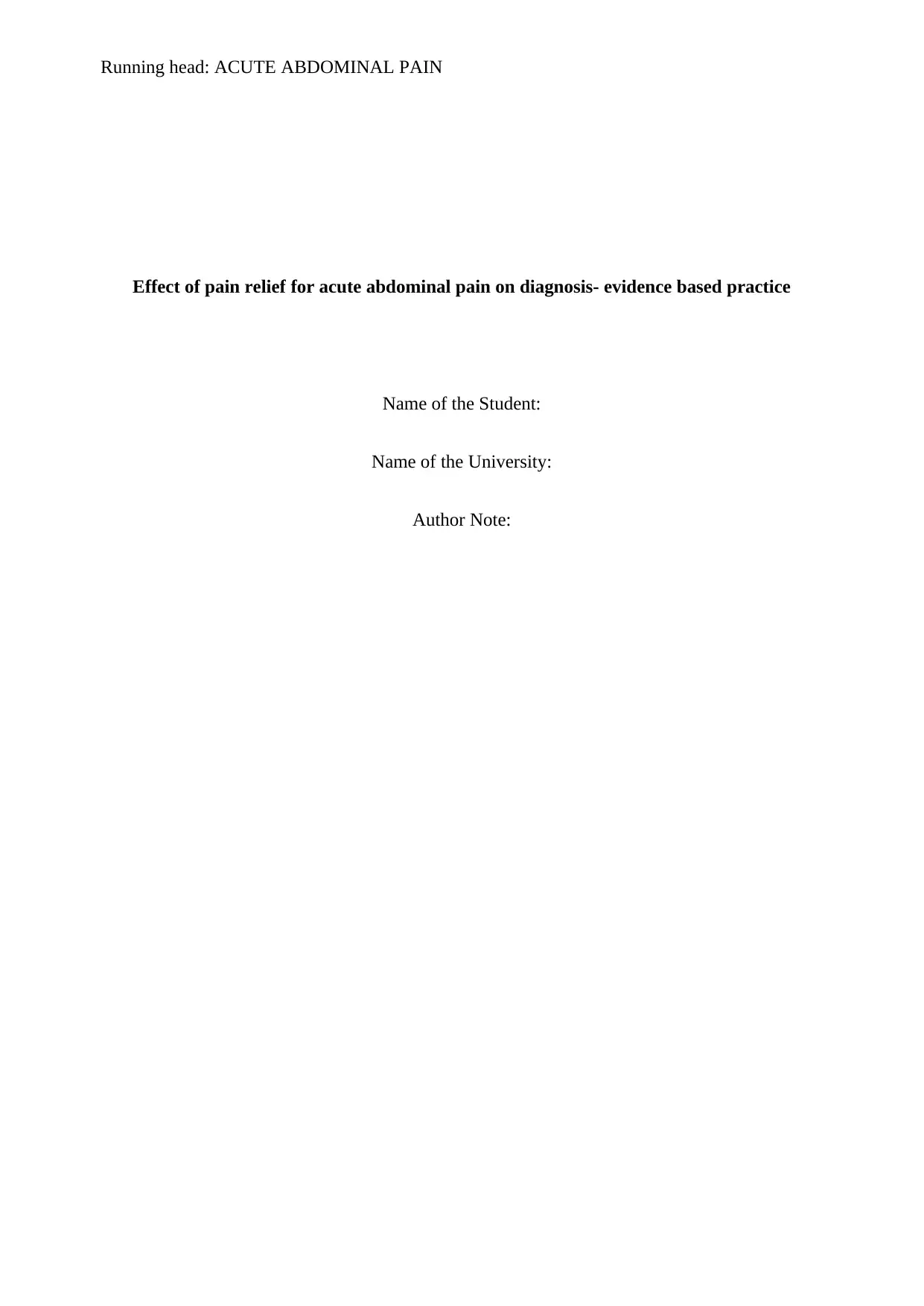
Running head: ACUTE ABDOMINAL PAIN
Effect of pain relief for acute abdominal pain on diagnosis- evidence based practice
Name of the Student:
Name of the University:
Author Note:
Effect of pain relief for acute abdominal pain on diagnosis- evidence based practice
Name of the Student:
Name of the University:
Author Note:
Paraphrase This Document
Need a fresh take? Get an instant paraphrase of this document with our AI Paraphraser
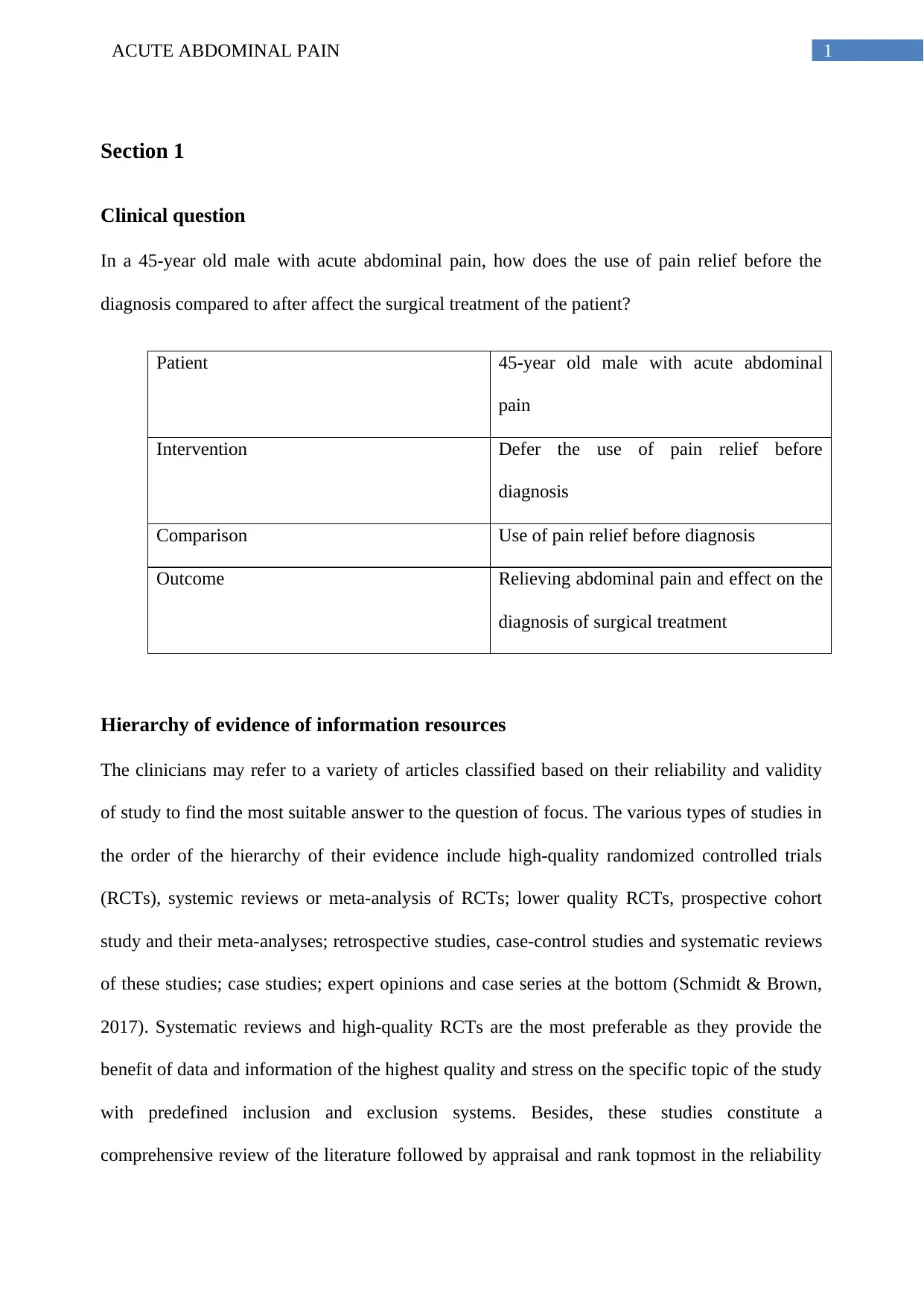
1ACUTE ABDOMINAL PAIN
Section 1
Clinical question
In a 45-year old male with acute abdominal pain, how does the use of pain relief before the
diagnosis compared to after affect the surgical treatment of the patient?
Patient 45-year old male with acute abdominal
pain
Intervention Defer the use of pain relief before
diagnosis
Comparison Use of pain relief before diagnosis
Outcome Relieving abdominal pain and effect on the
diagnosis of surgical treatment
Hierarchy of evidence of information resources
The clinicians may refer to a variety of articles classified based on their reliability and validity
of study to find the most suitable answer to the question of focus. The various types of studies in
the order of the hierarchy of their evidence include high-quality randomized controlled trials
(RCTs), systemic reviews or meta-analysis of RCTs; lower quality RCTs, prospective cohort
study and their meta-analyses; retrospective studies, case-control studies and systematic reviews
of these studies; case studies; expert opinions and case series at the bottom (Schmidt & Brown,
2017). Systematic reviews and high-quality RCTs are the most preferable as they provide the
benefit of data and information of the highest quality and stress on the specific topic of the study
with predefined inclusion and exclusion systems. Besides, these studies constitute a
comprehensive review of the literature followed by appraisal and rank topmost in the reliability
Section 1
Clinical question
In a 45-year old male with acute abdominal pain, how does the use of pain relief before the
diagnosis compared to after affect the surgical treatment of the patient?
Patient 45-year old male with acute abdominal
pain
Intervention Defer the use of pain relief before
diagnosis
Comparison Use of pain relief before diagnosis
Outcome Relieving abdominal pain and effect on the
diagnosis of surgical treatment
Hierarchy of evidence of information resources
The clinicians may refer to a variety of articles classified based on their reliability and validity
of study to find the most suitable answer to the question of focus. The various types of studies in
the order of the hierarchy of their evidence include high-quality randomized controlled trials
(RCTs), systemic reviews or meta-analysis of RCTs; lower quality RCTs, prospective cohort
study and their meta-analyses; retrospective studies, case-control studies and systematic reviews
of these studies; case studies; expert opinions and case series at the bottom (Schmidt & Brown,
2017). Systematic reviews and high-quality RCTs are the most preferable as they provide the
benefit of data and information of the highest quality and stress on the specific topic of the study
with predefined inclusion and exclusion systems. Besides, these studies constitute a
comprehensive review of the literature followed by appraisal and rank topmost in the reliability
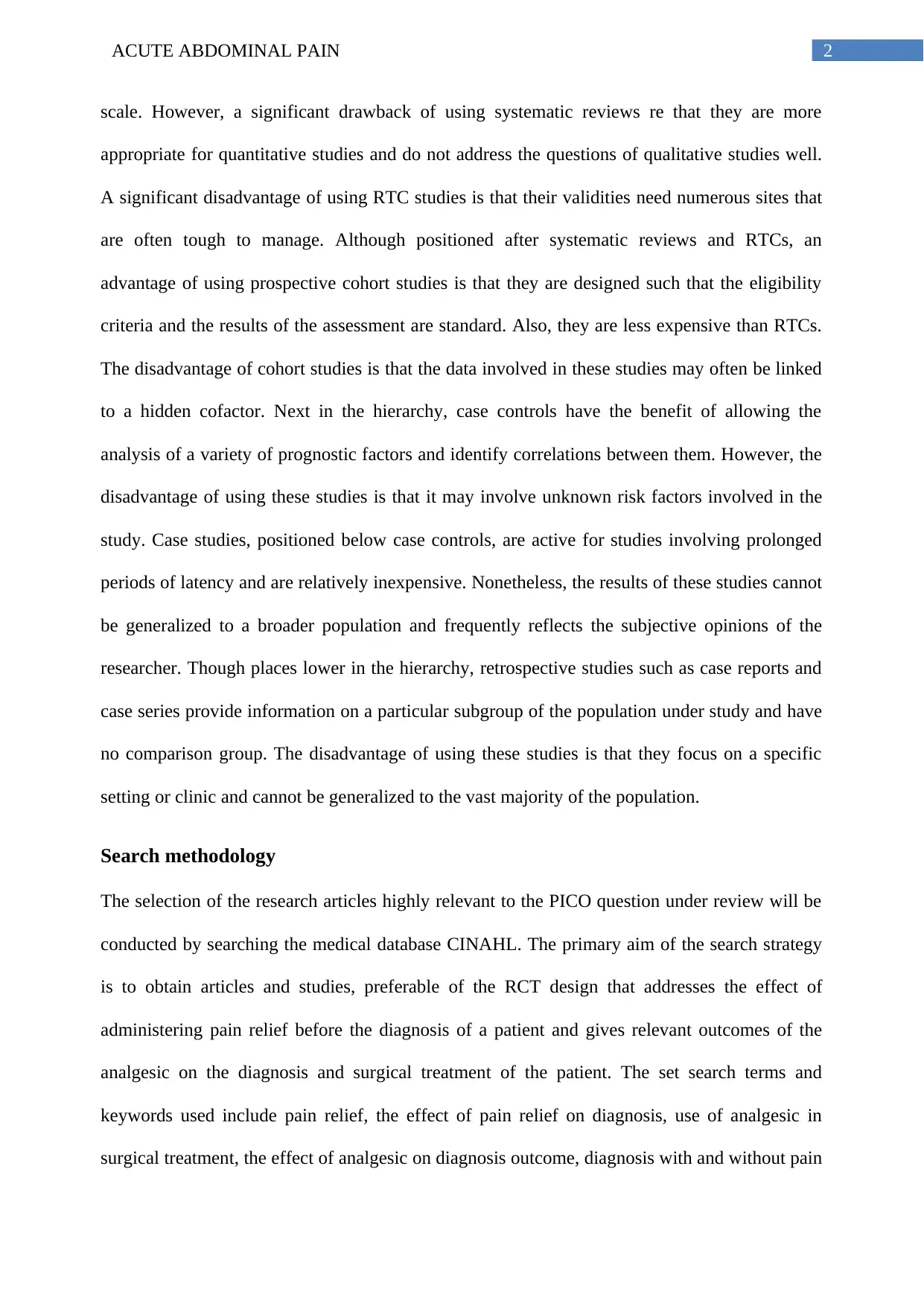
2ACUTE ABDOMINAL PAIN
scale. However, a significant drawback of using systematic reviews re that they are more
appropriate for quantitative studies and do not address the questions of qualitative studies well.
A significant disadvantage of using RTC studies is that their validities need numerous sites that
are often tough to manage. Although positioned after systematic reviews and RTCs, an
advantage of using prospective cohort studies is that they are designed such that the eligibility
criteria and the results of the assessment are standard. Also, they are less expensive than RTCs.
The disadvantage of cohort studies is that the data involved in these studies may often be linked
to a hidden cofactor. Next in the hierarchy, case controls have the benefit of allowing the
analysis of a variety of prognostic factors and identify correlations between them. However, the
disadvantage of using these studies is that it may involve unknown risk factors involved in the
study. Case studies, positioned below case controls, are active for studies involving prolonged
periods of latency and are relatively inexpensive. Nonetheless, the results of these studies cannot
be generalized to a broader population and frequently reflects the subjective opinions of the
researcher. Though places lower in the hierarchy, retrospective studies such as case reports and
case series provide information on a particular subgroup of the population under study and have
no comparison group. The disadvantage of using these studies is that they focus on a specific
setting or clinic and cannot be generalized to the vast majority of the population.
Search methodology
The selection of the research articles highly relevant to the PICO question under review will be
conducted by searching the medical database CINAHL. The primary aim of the search strategy
is to obtain articles and studies, preferable of the RCT design that addresses the effect of
administering pain relief before the diagnosis of a patient and gives relevant outcomes of the
analgesic on the diagnosis and surgical treatment of the patient. The set search terms and
keywords used include pain relief, the effect of pain relief on diagnosis, use of analgesic in
surgical treatment, the effect of analgesic on diagnosis outcome, diagnosis with and without pain
scale. However, a significant drawback of using systematic reviews re that they are more
appropriate for quantitative studies and do not address the questions of qualitative studies well.
A significant disadvantage of using RTC studies is that their validities need numerous sites that
are often tough to manage. Although positioned after systematic reviews and RTCs, an
advantage of using prospective cohort studies is that they are designed such that the eligibility
criteria and the results of the assessment are standard. Also, they are less expensive than RTCs.
The disadvantage of cohort studies is that the data involved in these studies may often be linked
to a hidden cofactor. Next in the hierarchy, case controls have the benefit of allowing the
analysis of a variety of prognostic factors and identify correlations between them. However, the
disadvantage of using these studies is that it may involve unknown risk factors involved in the
study. Case studies, positioned below case controls, are active for studies involving prolonged
periods of latency and are relatively inexpensive. Nonetheless, the results of these studies cannot
be generalized to a broader population and frequently reflects the subjective opinions of the
researcher. Though places lower in the hierarchy, retrospective studies such as case reports and
case series provide information on a particular subgroup of the population under study and have
no comparison group. The disadvantage of using these studies is that they focus on a specific
setting or clinic and cannot be generalized to the vast majority of the population.
Search methodology
The selection of the research articles highly relevant to the PICO question under review will be
conducted by searching the medical database CINAHL. The primary aim of the search strategy
is to obtain articles and studies, preferable of the RCT design that addresses the effect of
administering pain relief before the diagnosis of a patient and gives relevant outcomes of the
analgesic on the diagnosis and surgical treatment of the patient. The set search terms and
keywords used include pain relief, the effect of pain relief on diagnosis, use of analgesic in
surgical treatment, the effect of analgesic on diagnosis outcome, diagnosis with and without pain
⊘ This is a preview!⊘
Do you want full access?
Subscribe today to unlock all pages.

Trusted by 1+ million students worldwide
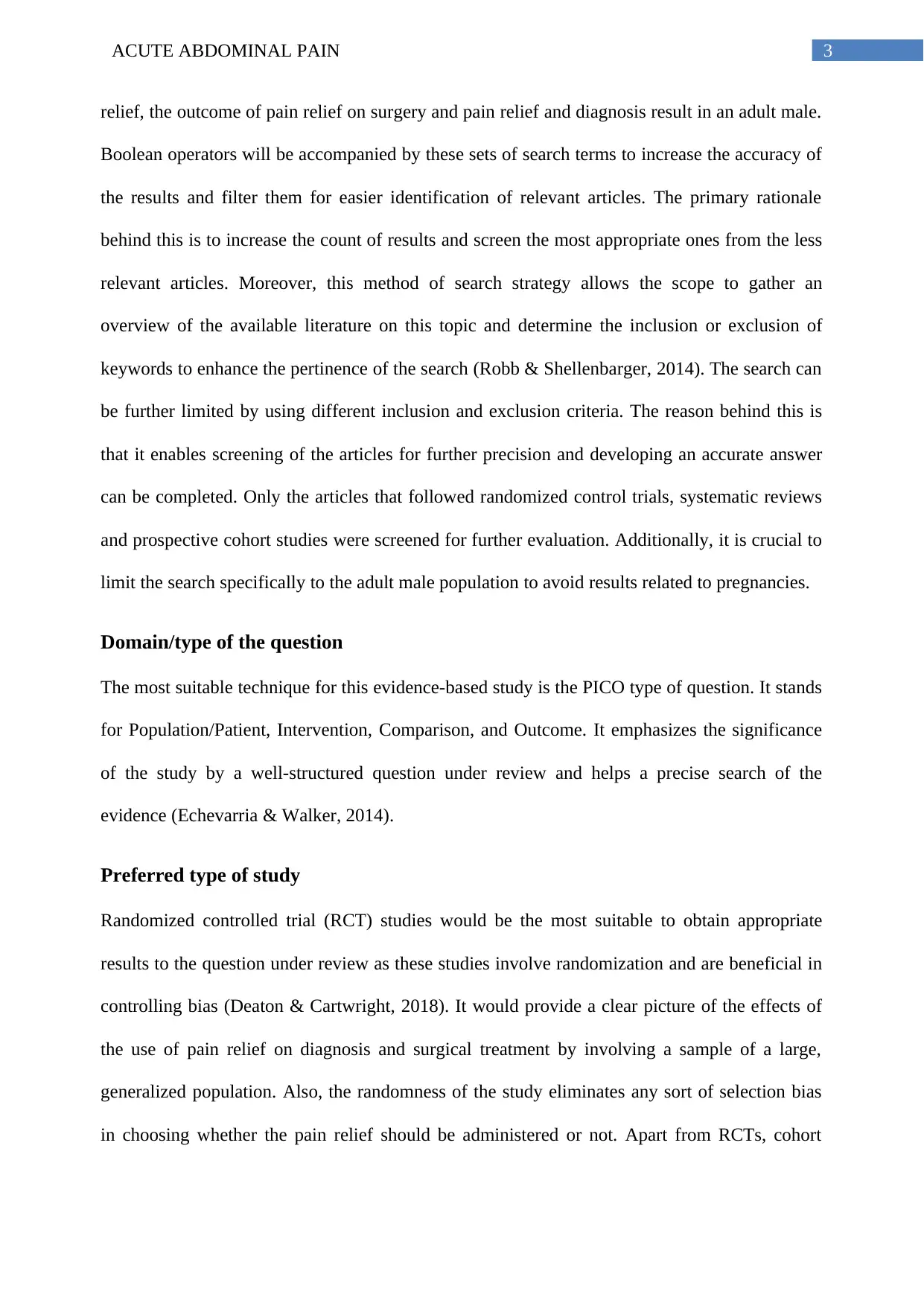
3ACUTE ABDOMINAL PAIN
relief, the outcome of pain relief on surgery and pain relief and diagnosis result in an adult male.
Boolean operators will be accompanied by these sets of search terms to increase the accuracy of
the results and filter them for easier identification of relevant articles. The primary rationale
behind this is to increase the count of results and screen the most appropriate ones from the less
relevant articles. Moreover, this method of search strategy allows the scope to gather an
overview of the available literature on this topic and determine the inclusion or exclusion of
keywords to enhance the pertinence of the search (Robb & Shellenbarger, 2014). The search can
be further limited by using different inclusion and exclusion criteria. The reason behind this is
that it enables screening of the articles for further precision and developing an accurate answer
can be completed. Only the articles that followed randomized control trials, systematic reviews
and prospective cohort studies were screened for further evaluation. Additionally, it is crucial to
limit the search specifically to the adult male population to avoid results related to pregnancies.
Domain/type of the question
The most suitable technique for this evidence-based study is the PICO type of question. It stands
for Population/Patient, Intervention, Comparison, and Outcome. It emphasizes the significance
of the study by a well-structured question under review and helps a precise search of the
evidence (Echevarria & Walker, 2014).
Preferred type of study
Randomized controlled trial (RCT) studies would be the most suitable to obtain appropriate
results to the question under review as these studies involve randomization and are beneficial in
controlling bias (Deaton & Cartwright, 2018). It would provide a clear picture of the effects of
the use of pain relief on diagnosis and surgical treatment by involving a sample of a large,
generalized population. Also, the randomness of the study eliminates any sort of selection bias
in choosing whether the pain relief should be administered or not. Apart from RCTs, cohort
relief, the outcome of pain relief on surgery and pain relief and diagnosis result in an adult male.
Boolean operators will be accompanied by these sets of search terms to increase the accuracy of
the results and filter them for easier identification of relevant articles. The primary rationale
behind this is to increase the count of results and screen the most appropriate ones from the less
relevant articles. Moreover, this method of search strategy allows the scope to gather an
overview of the available literature on this topic and determine the inclusion or exclusion of
keywords to enhance the pertinence of the search (Robb & Shellenbarger, 2014). The search can
be further limited by using different inclusion and exclusion criteria. The reason behind this is
that it enables screening of the articles for further precision and developing an accurate answer
can be completed. Only the articles that followed randomized control trials, systematic reviews
and prospective cohort studies were screened for further evaluation. Additionally, it is crucial to
limit the search specifically to the adult male population to avoid results related to pregnancies.
Domain/type of the question
The most suitable technique for this evidence-based study is the PICO type of question. It stands
for Population/Patient, Intervention, Comparison, and Outcome. It emphasizes the significance
of the study by a well-structured question under review and helps a precise search of the
evidence (Echevarria & Walker, 2014).
Preferred type of study
Randomized controlled trial (RCT) studies would be the most suitable to obtain appropriate
results to the question under review as these studies involve randomization and are beneficial in
controlling bias (Deaton & Cartwright, 2018). It would provide a clear picture of the effects of
the use of pain relief on diagnosis and surgical treatment by involving a sample of a large,
generalized population. Also, the randomness of the study eliminates any sort of selection bias
in choosing whether the pain relief should be administered or not. Apart from RCTs, cohort
Paraphrase This Document
Need a fresh take? Get an instant paraphrase of this document with our AI Paraphraser
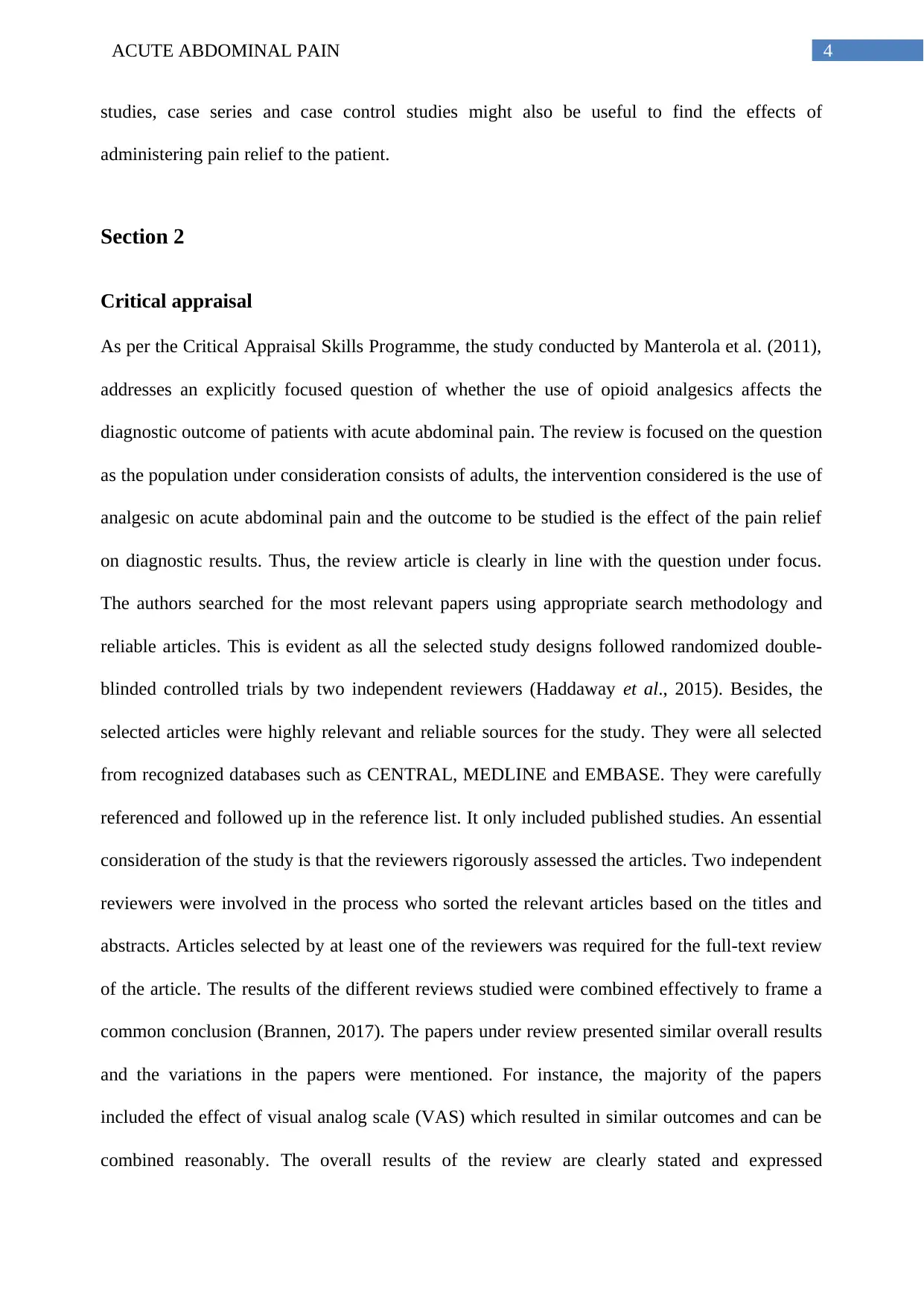
4ACUTE ABDOMINAL PAIN
studies, case series and case control studies might also be useful to find the effects of
administering pain relief to the patient.
Section 2
Critical appraisal
As per the Critical Appraisal Skills Programme, the study conducted by Manterola et al. (2011),
addresses an explicitly focused question of whether the use of opioid analgesics affects the
diagnostic outcome of patients with acute abdominal pain. The review is focused on the question
as the population under consideration consists of adults, the intervention considered is the use of
analgesic on acute abdominal pain and the outcome to be studied is the effect of the pain relief
on diagnostic results. Thus, the review article is clearly in line with the question under focus.
The authors searched for the most relevant papers using appropriate search methodology and
reliable articles. This is evident as all the selected study designs followed randomized double-
blinded controlled trials by two independent reviewers (Haddaway et al., 2015). Besides, the
selected articles were highly relevant and reliable sources for the study. They were all selected
from recognized databases such as CENTRAL, MEDLINE and EMBASE. They were carefully
referenced and followed up in the reference list. It only included published studies. An essential
consideration of the study is that the reviewers rigorously assessed the articles. Two independent
reviewers were involved in the process who sorted the relevant articles based on the titles and
abstracts. Articles selected by at least one of the reviewers was required for the full-text review
of the article. The results of the different reviews studied were combined effectively to frame a
common conclusion (Brannen, 2017). The papers under review presented similar overall results
and the variations in the papers were mentioned. For instance, the majority of the papers
included the effect of visual analog scale (VAS) which resulted in similar outcomes and can be
combined reasonably. The overall results of the review are clearly stated and expressed
studies, case series and case control studies might also be useful to find the effects of
administering pain relief to the patient.
Section 2
Critical appraisal
As per the Critical Appraisal Skills Programme, the study conducted by Manterola et al. (2011),
addresses an explicitly focused question of whether the use of opioid analgesics affects the
diagnostic outcome of patients with acute abdominal pain. The review is focused on the question
as the population under consideration consists of adults, the intervention considered is the use of
analgesic on acute abdominal pain and the outcome to be studied is the effect of the pain relief
on diagnostic results. Thus, the review article is clearly in line with the question under focus.
The authors searched for the most relevant papers using appropriate search methodology and
reliable articles. This is evident as all the selected study designs followed randomized double-
blinded controlled trials by two independent reviewers (Haddaway et al., 2015). Besides, the
selected articles were highly relevant and reliable sources for the study. They were all selected
from recognized databases such as CENTRAL, MEDLINE and EMBASE. They were carefully
referenced and followed up in the reference list. It only included published studies. An essential
consideration of the study is that the reviewers rigorously assessed the articles. Two independent
reviewers were involved in the process who sorted the relevant articles based on the titles and
abstracts. Articles selected by at least one of the reviewers was required for the full-text review
of the article. The results of the different reviews studied were combined effectively to frame a
common conclusion (Brannen, 2017). The papers under review presented similar overall results
and the variations in the papers were mentioned. For instance, the majority of the papers
included the effect of visual analog scale (VAS) which resulted in similar outcomes and can be
combined reasonably. The overall results of the review are clearly stated and expressed
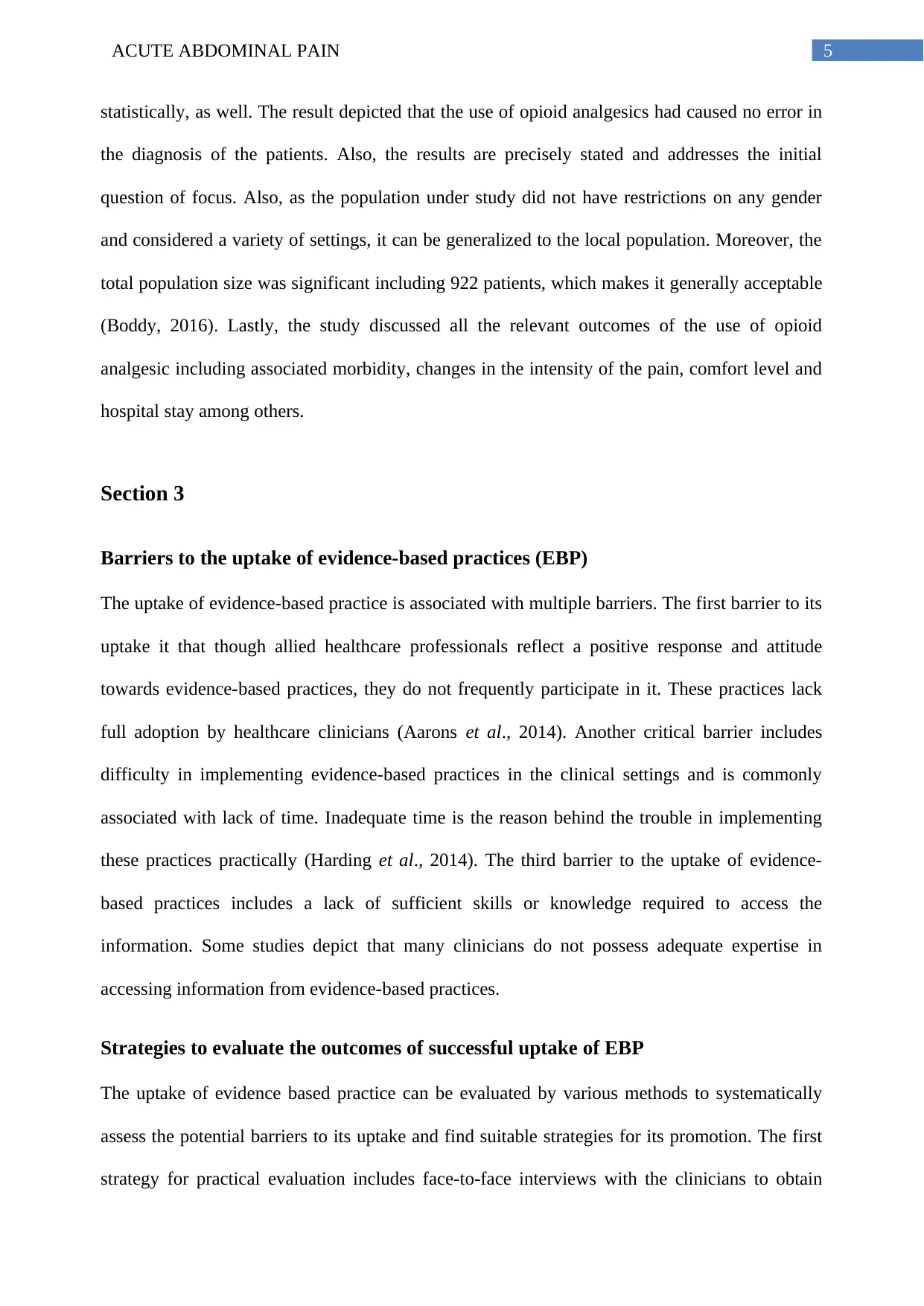
5ACUTE ABDOMINAL PAIN
statistically, as well. The result depicted that the use of opioid analgesics had caused no error in
the diagnosis of the patients. Also, the results are precisely stated and addresses the initial
question of focus. Also, as the population under study did not have restrictions on any gender
and considered a variety of settings, it can be generalized to the local population. Moreover, the
total population size was significant including 922 patients, which makes it generally acceptable
(Boddy, 2016). Lastly, the study discussed all the relevant outcomes of the use of opioid
analgesic including associated morbidity, changes in the intensity of the pain, comfort level and
hospital stay among others.
Section 3
Barriers to the uptake of evidence-based practices (EBP)
The uptake of evidence-based practice is associated with multiple barriers. The first barrier to its
uptake it that though allied healthcare professionals reflect a positive response and attitude
towards evidence-based practices, they do not frequently participate in it. These practices lack
full adoption by healthcare clinicians (Aarons et al., 2014). Another critical barrier includes
difficulty in implementing evidence-based practices in the clinical settings and is commonly
associated with lack of time. Inadequate time is the reason behind the trouble in implementing
these practices practically (Harding et al., 2014). The third barrier to the uptake of evidence-
based practices includes a lack of sufficient skills or knowledge required to access the
information. Some studies depict that many clinicians do not possess adequate expertise in
accessing information from evidence-based practices.
Strategies to evaluate the outcomes of successful uptake of EBP
The uptake of evidence based practice can be evaluated by various methods to systematically
assess the potential barriers to its uptake and find suitable strategies for its promotion. The first
strategy for practical evaluation includes face-to-face interviews with the clinicians to obtain
statistically, as well. The result depicted that the use of opioid analgesics had caused no error in
the diagnosis of the patients. Also, the results are precisely stated and addresses the initial
question of focus. Also, as the population under study did not have restrictions on any gender
and considered a variety of settings, it can be generalized to the local population. Moreover, the
total population size was significant including 922 patients, which makes it generally acceptable
(Boddy, 2016). Lastly, the study discussed all the relevant outcomes of the use of opioid
analgesic including associated morbidity, changes in the intensity of the pain, comfort level and
hospital stay among others.
Section 3
Barriers to the uptake of evidence-based practices (EBP)
The uptake of evidence-based practice is associated with multiple barriers. The first barrier to its
uptake it that though allied healthcare professionals reflect a positive response and attitude
towards evidence-based practices, they do not frequently participate in it. These practices lack
full adoption by healthcare clinicians (Aarons et al., 2014). Another critical barrier includes
difficulty in implementing evidence-based practices in the clinical settings and is commonly
associated with lack of time. Inadequate time is the reason behind the trouble in implementing
these practices practically (Harding et al., 2014). The third barrier to the uptake of evidence-
based practices includes a lack of sufficient skills or knowledge required to access the
information. Some studies depict that many clinicians do not possess adequate expertise in
accessing information from evidence-based practices.
Strategies to evaluate the outcomes of successful uptake of EBP
The uptake of evidence based practice can be evaluated by various methods to systematically
assess the potential barriers to its uptake and find suitable strategies for its promotion. The first
strategy for practical evaluation includes face-to-face interviews with the clinicians to obtain
⊘ This is a preview!⊘
Do you want full access?
Subscribe today to unlock all pages.

Trusted by 1+ million students worldwide
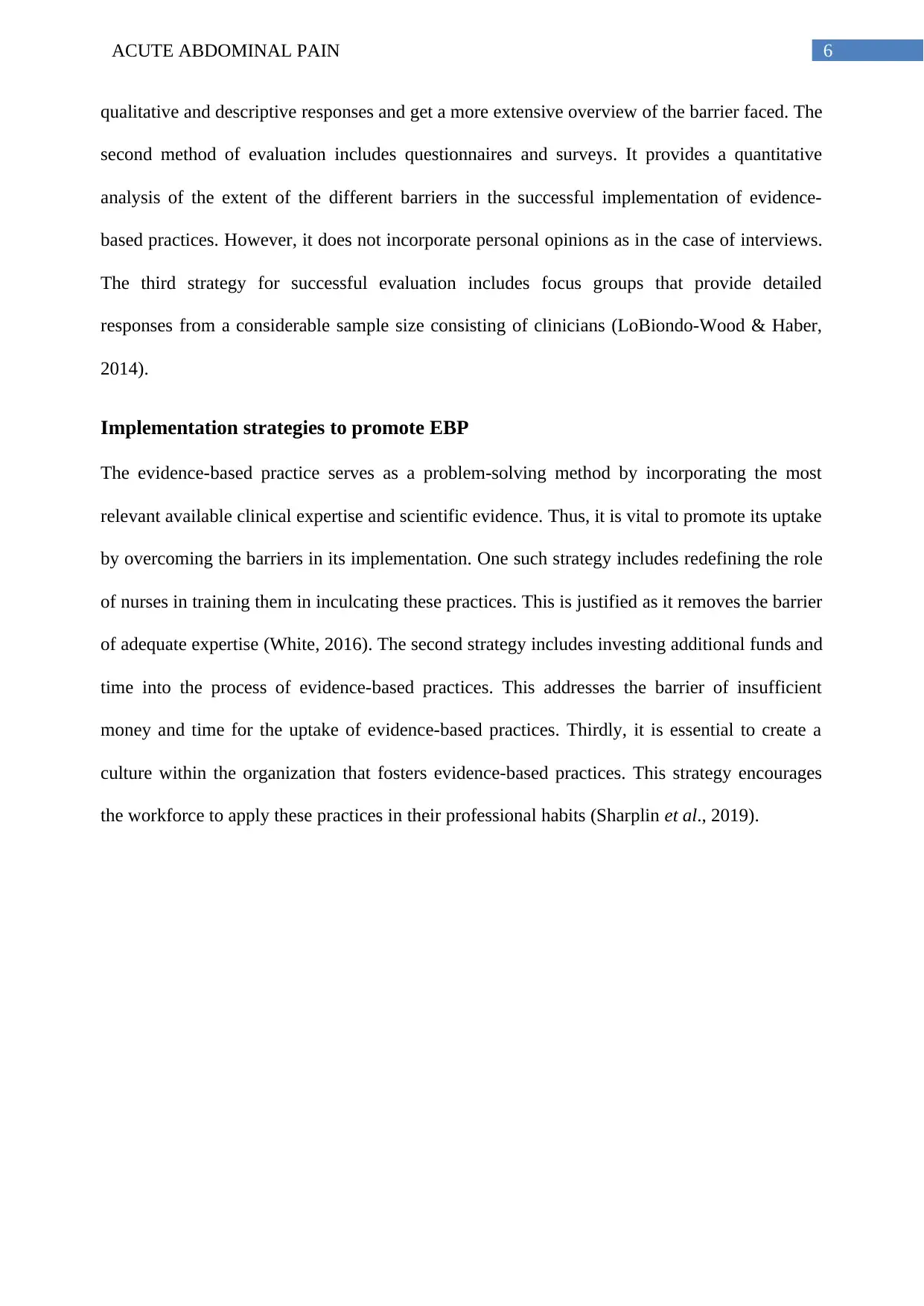
6ACUTE ABDOMINAL PAIN
qualitative and descriptive responses and get a more extensive overview of the barrier faced. The
second method of evaluation includes questionnaires and surveys. It provides a quantitative
analysis of the extent of the different barriers in the successful implementation of evidence-
based practices. However, it does not incorporate personal opinions as in the case of interviews.
The third strategy for successful evaluation includes focus groups that provide detailed
responses from a considerable sample size consisting of clinicians (LoBiondo-Wood & Haber,
2014).
Implementation strategies to promote EBP
The evidence-based practice serves as a problem-solving method by incorporating the most
relevant available clinical expertise and scientific evidence. Thus, it is vital to promote its uptake
by overcoming the barriers in its implementation. One such strategy includes redefining the role
of nurses in training them in inculcating these practices. This is justified as it removes the barrier
of adequate expertise (White, 2016). The second strategy includes investing additional funds and
time into the process of evidence-based practices. This addresses the barrier of insufficient
money and time for the uptake of evidence-based practices. Thirdly, it is essential to create a
culture within the organization that fosters evidence-based practices. This strategy encourages
the workforce to apply these practices in their professional habits (Sharplin et al., 2019).
qualitative and descriptive responses and get a more extensive overview of the barrier faced. The
second method of evaluation includes questionnaires and surveys. It provides a quantitative
analysis of the extent of the different barriers in the successful implementation of evidence-
based practices. However, it does not incorporate personal opinions as in the case of interviews.
The third strategy for successful evaluation includes focus groups that provide detailed
responses from a considerable sample size consisting of clinicians (LoBiondo-Wood & Haber,
2014).
Implementation strategies to promote EBP
The evidence-based practice serves as a problem-solving method by incorporating the most
relevant available clinical expertise and scientific evidence. Thus, it is vital to promote its uptake
by overcoming the barriers in its implementation. One such strategy includes redefining the role
of nurses in training them in inculcating these practices. This is justified as it removes the barrier
of adequate expertise (White, 2016). The second strategy includes investing additional funds and
time into the process of evidence-based practices. This addresses the barrier of insufficient
money and time for the uptake of evidence-based practices. Thirdly, it is essential to create a
culture within the organization that fosters evidence-based practices. This strategy encourages
the workforce to apply these practices in their professional habits (Sharplin et al., 2019).
Paraphrase This Document
Need a fresh take? Get an instant paraphrase of this document with our AI Paraphraser
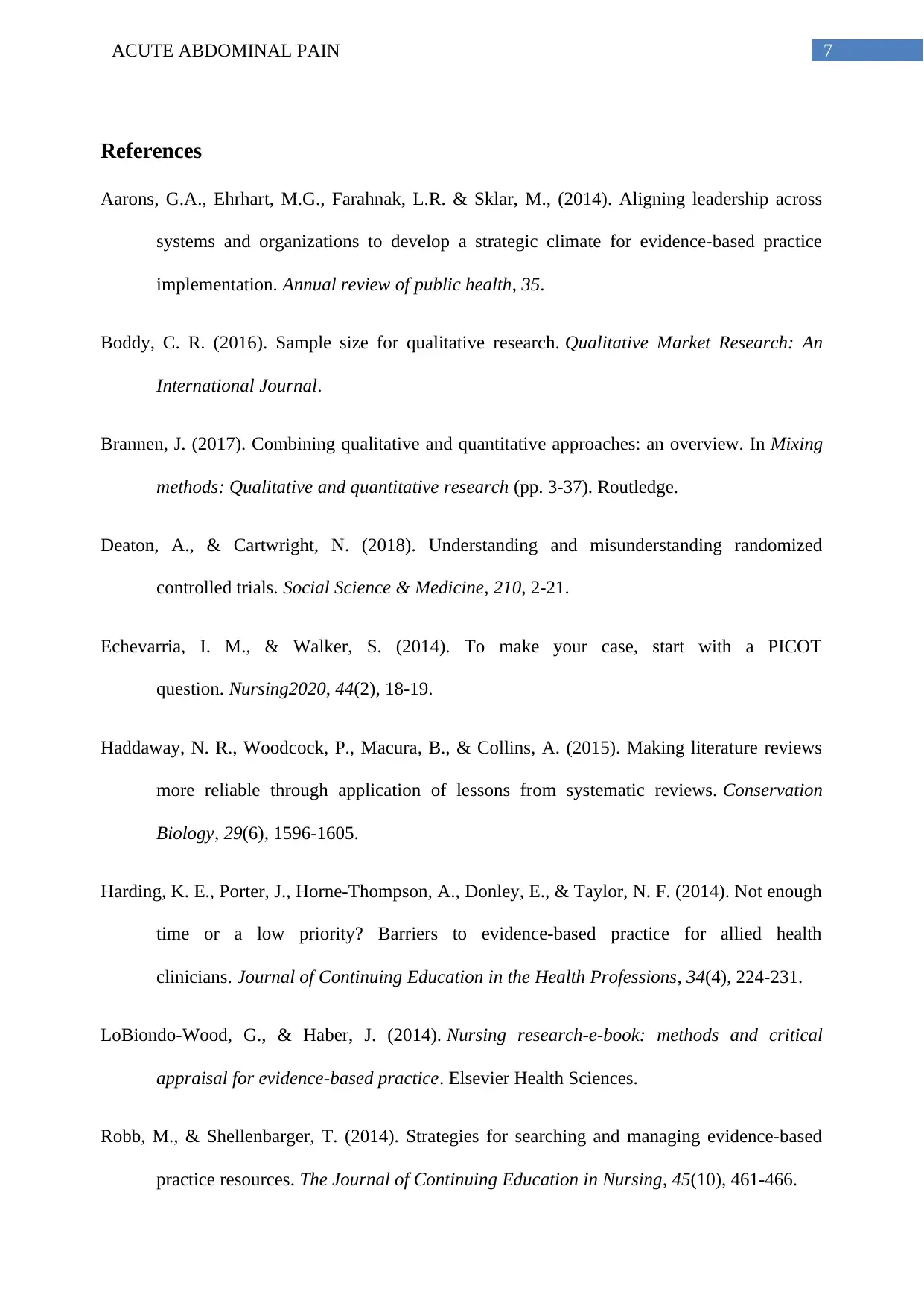
7ACUTE ABDOMINAL PAIN
References
Aarons, G.A., Ehrhart, M.G., Farahnak, L.R. & Sklar, M., (2014). Aligning leadership across
systems and organizations to develop a strategic climate for evidence-based practice
implementation. Annual review of public health, 35.
Boddy, C. R. (2016). Sample size for qualitative research. Qualitative Market Research: An
International Journal.
Brannen, J. (2017). Combining qualitative and quantitative approaches: an overview. In Mixing
methods: Qualitative and quantitative research (pp. 3-37). Routledge.
Deaton, A., & Cartwright, N. (2018). Understanding and misunderstanding randomized
controlled trials. Social Science & Medicine, 210, 2-21.
Echevarria, I. M., & Walker, S. (2014). To make your case, start with a PICOT
question. Nursing2020, 44(2), 18-19.
Haddaway, N. R., Woodcock, P., Macura, B., & Collins, A. (2015). Making literature reviews
more reliable through application of lessons from systematic reviews. Conservation
Biology, 29(6), 1596-1605.
Harding, K. E., Porter, J., Horne‐Thompson, A., Donley, E., & Taylor, N. F. (2014). Not enough
time or a low priority? Barriers to evidence‐based practice for allied health
clinicians. Journal of Continuing Education in the Health Professions, 34(4), 224-231.
LoBiondo-Wood, G., & Haber, J. (2014). Nursing research-e-book: methods and critical
appraisal for evidence-based practice. Elsevier Health Sciences.
Robb, M., & Shellenbarger, T. (2014). Strategies for searching and managing evidence-based
practice resources. The Journal of Continuing Education in Nursing, 45(10), 461-466.
References
Aarons, G.A., Ehrhart, M.G., Farahnak, L.R. & Sklar, M., (2014). Aligning leadership across
systems and organizations to develop a strategic climate for evidence-based practice
implementation. Annual review of public health, 35.
Boddy, C. R. (2016). Sample size for qualitative research. Qualitative Market Research: An
International Journal.
Brannen, J. (2017). Combining qualitative and quantitative approaches: an overview. In Mixing
methods: Qualitative and quantitative research (pp. 3-37). Routledge.
Deaton, A., & Cartwright, N. (2018). Understanding and misunderstanding randomized
controlled trials. Social Science & Medicine, 210, 2-21.
Echevarria, I. M., & Walker, S. (2014). To make your case, start with a PICOT
question. Nursing2020, 44(2), 18-19.
Haddaway, N. R., Woodcock, P., Macura, B., & Collins, A. (2015). Making literature reviews
more reliable through application of lessons from systematic reviews. Conservation
Biology, 29(6), 1596-1605.
Harding, K. E., Porter, J., Horne‐Thompson, A., Donley, E., & Taylor, N. F. (2014). Not enough
time or a low priority? Barriers to evidence‐based practice for allied health
clinicians. Journal of Continuing Education in the Health Professions, 34(4), 224-231.
LoBiondo-Wood, G., & Haber, J. (2014). Nursing research-e-book: methods and critical
appraisal for evidence-based practice. Elsevier Health Sciences.
Robb, M., & Shellenbarger, T. (2014). Strategies for searching and managing evidence-based
practice resources. The Journal of Continuing Education in Nursing, 45(10), 461-466.
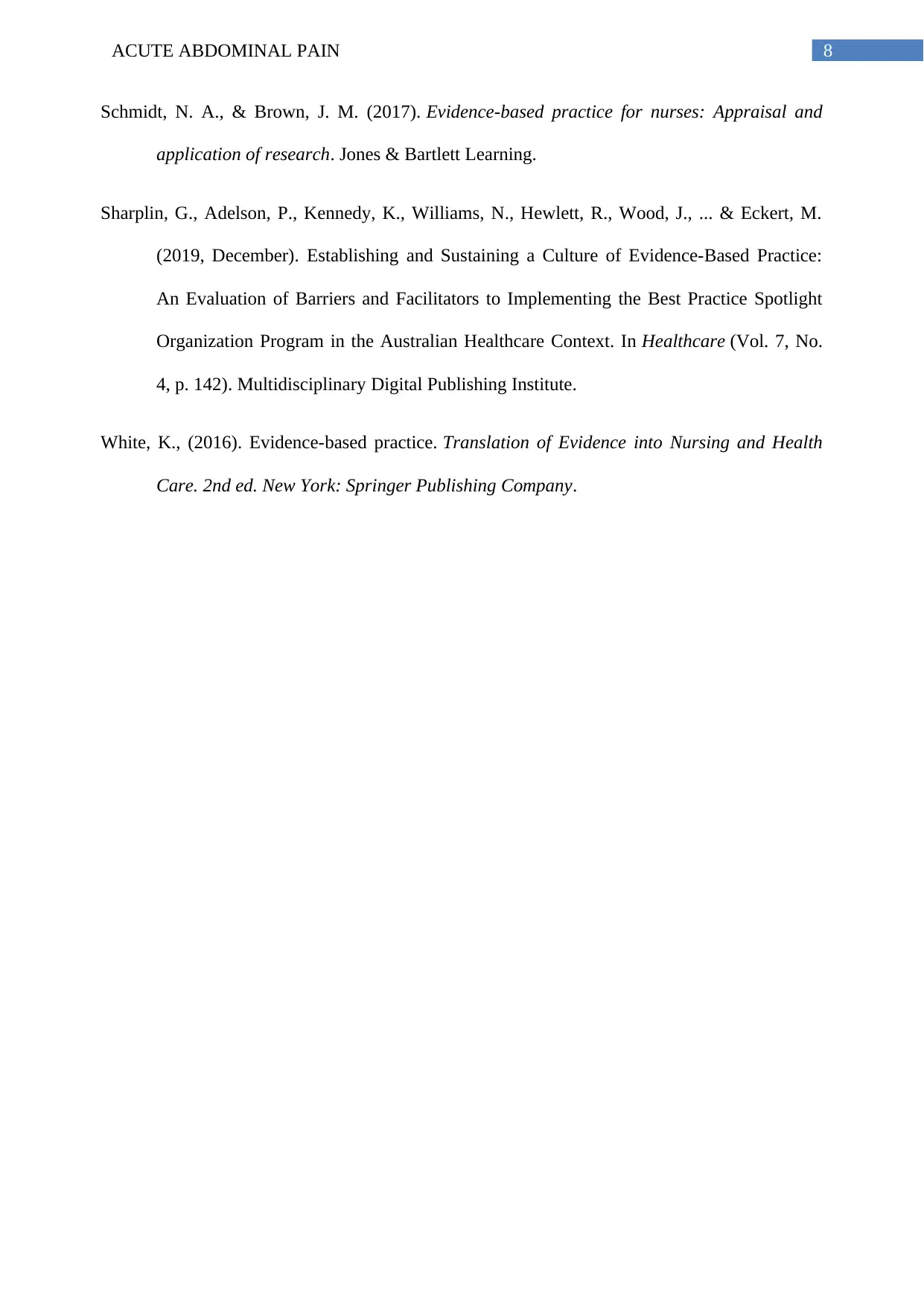
8ACUTE ABDOMINAL PAIN
Schmidt, N. A., & Brown, J. M. (2017). Evidence-based practice for nurses: Appraisal and
application of research. Jones & Bartlett Learning.
Sharplin, G., Adelson, P., Kennedy, K., Williams, N., Hewlett, R., Wood, J., ... & Eckert, M.
(2019, December). Establishing and Sustaining a Culture of Evidence-Based Practice:
An Evaluation of Barriers and Facilitators to Implementing the Best Practice Spotlight
Organization Program in the Australian Healthcare Context. In Healthcare (Vol. 7, No.
4, p. 142). Multidisciplinary Digital Publishing Institute.
White, K., (2016). Evidence-based practice. Translation of Evidence into Nursing and Health
Care. 2nd ed. New York: Springer Publishing Company.
Schmidt, N. A., & Brown, J. M. (2017). Evidence-based practice for nurses: Appraisal and
application of research. Jones & Bartlett Learning.
Sharplin, G., Adelson, P., Kennedy, K., Williams, N., Hewlett, R., Wood, J., ... & Eckert, M.
(2019, December). Establishing and Sustaining a Culture of Evidence-Based Practice:
An Evaluation of Barriers and Facilitators to Implementing the Best Practice Spotlight
Organization Program in the Australian Healthcare Context. In Healthcare (Vol. 7, No.
4, p. 142). Multidisciplinary Digital Publishing Institute.
White, K., (2016). Evidence-based practice. Translation of Evidence into Nursing and Health
Care. 2nd ed. New York: Springer Publishing Company.
⊘ This is a preview!⊘
Do you want full access?
Subscribe today to unlock all pages.

Trusted by 1+ million students worldwide
1 out of 9
Your All-in-One AI-Powered Toolkit for Academic Success.
+13062052269
info@desklib.com
Available 24*7 on WhatsApp / Email
![[object Object]](/_next/static/media/star-bottom.7253800d.svg)
Unlock your academic potential
Copyright © 2020–2025 A2Z Services. All Rights Reserved. Developed and managed by ZUCOL.


